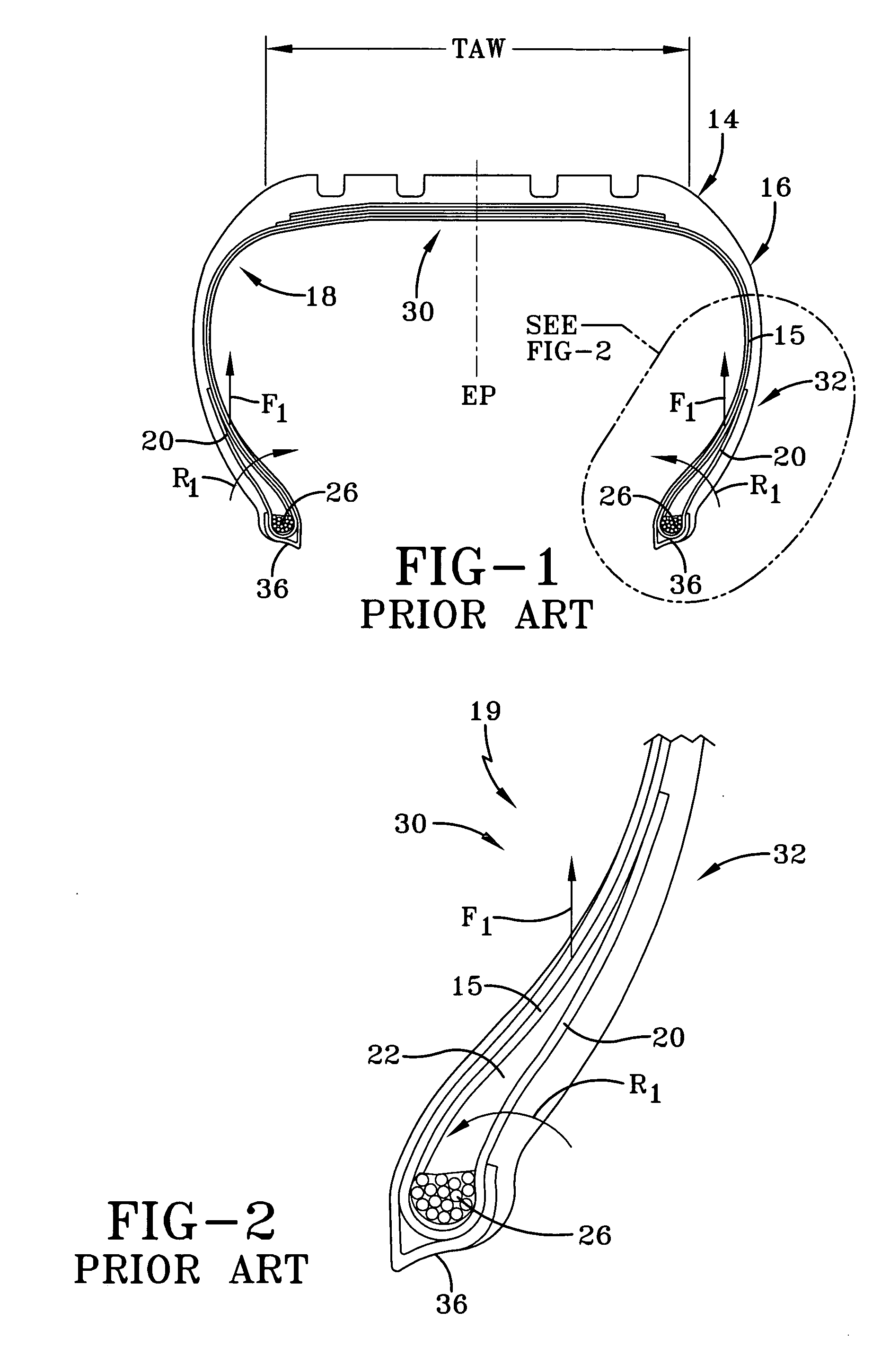Tire with turned down ply construction
a technology of ply construction and tires, which is applied in the field of pneumatic tires, can solve the problems of significant reduction of material expenses of a manufacturer engaged in high-volume tire production, and achieve the effects of reducing rim indentation, reducing material expenses, and increasing the support of tires
- Summary
- Abstract
- Description
- Claims
- Application Information
AI Technical Summary
Benefits of technology
Problems solved by technology
Method used
Image
Examples
first embodiment
[0039] With particular reference to FIG. 3, there is illustrated a cross-sectional view of a tire 100 of the present invention. The tire 100 has a tread portion 102 and a pair of sidewalls 104a,b wherein the sidewalls are connected to the tread portion by shoulder regions 106. The tire may have one or more reinforcing belts 108 which laterally extend under the tread 102. A carcass 110 of the tire includes an innerliner 112 which extends from bead 114a to bead 114b. The carcass further comprises a first ply layer 120 and a second ply layer 130. The carcass may comprise additional ply layers if needed. The first ply 120 has a reverse turned up end with the end 122 of the ply located on the interior portion 124 of the tire. The first ply 120 extends down from the turned up end 122, wraps along the outer portion of bead 114a, up the sidewall 104a, under the tread 102, down the sidewall 104b with a second end 128 extending down to bead 114b. The second end 128 does not wrap around bead 1...
second embodiment
[0045] A cross-sectional view of a tire assembly 200 is shown in FIG. 5. The tire assembly 200 includes all of the tire components as shown in FIG. 3 and described above, except that a different ply construction is utilized. Instead of ply layers 120,130 as described above, ply layers 210,220 are utilized. Ply layer 210 is located radially outward of the inner liner 112, and has a first end 212 located adjacent bead 114b. The ply layer 210 extends up from the first end 212, up the sidewall 104b, under the tread 102, down the other sidewall 104a and extends down to the other bead 114a. The ends 212,214 of ply layer 210 do not wrap around either bead.
[0046] A second layer of sidewall ply 220a,b is located radially outward of the first layer of ply 210 in the sidewall and shoulder area. A first sidewall ply 220a has a first end 222 located under the inner tread belt 108 and extends down the sidewall 104a, wraps around the bead 114a and optional apex 116a, and has a turned up end 224 lo...
third embodiment
[0050] A cross-sectional view of a tire assembly 300 is shown in FIG. 7. The tire assembly 300 includes all of the tire components as shown in FIG. 5 and described for tire assembly 200 above, except that shoulder inserts are additionally utilized for a run flat or extended mobility tire construction. A first shoulder insert 310a,b is located between the liner 112 and the bead to bead ply 210 in the shoulder of the tire assembly 300. The shoulder insert extends from near the top of apex 116 to near the edge of the belts 108 in the shoulder area. An optional second set of shoulder inserts 320a,b are located between the bead to bead ply 210 and the shoulder plies 220a,b. The second set of shoulder inserts 320a,b extend from near the edge of belts 108 to near the apex 116a,b.
[0051] The layout of the tire components is shown in FIGS. 8A and 8B. As shown in FIG. 8A, first an inner liner 112 is laid up on the midsection of a tire building drum 200. Next, a first and second toeguard 140a,...
PUM
 Login to View More
Login to View More Abstract
Description
Claims
Application Information
 Login to View More
Login to View More - R&D
- Intellectual Property
- Life Sciences
- Materials
- Tech Scout
- Unparalleled Data Quality
- Higher Quality Content
- 60% Fewer Hallucinations
Browse by: Latest US Patents, China's latest patents, Technical Efficacy Thesaurus, Application Domain, Technology Topic, Popular Technical Reports.
© 2025 PatSnap. All rights reserved.Legal|Privacy policy|Modern Slavery Act Transparency Statement|Sitemap|About US| Contact US: help@patsnap.com



